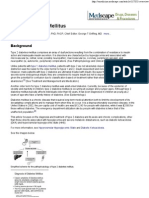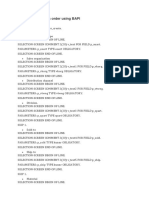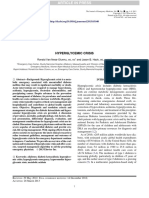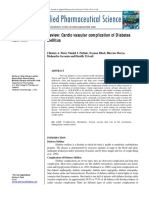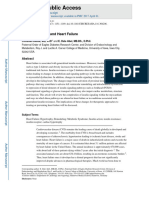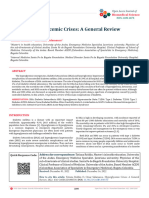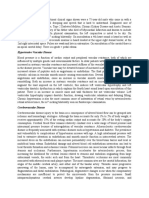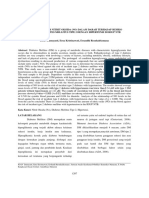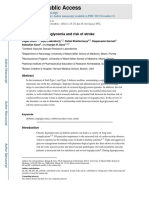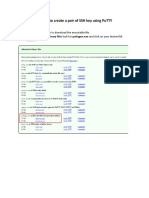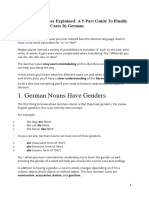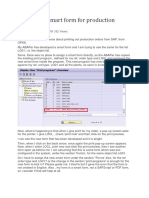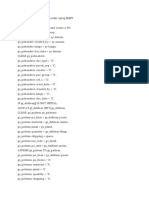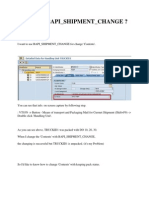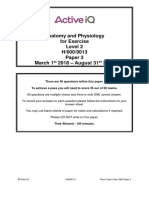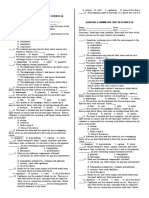Diabetes and Hypertension Physiopathology and Therapeutics: Journal of Human Hypertension May 2000
Diabetes and Hypertension Physiopathology and Therapeutics: Journal of Human Hypertension May 2000
Uploaded by
chandra9000Copyright:
Available Formats
Diabetes and Hypertension Physiopathology and Therapeutics: Journal of Human Hypertension May 2000
Diabetes and Hypertension Physiopathology and Therapeutics: Journal of Human Hypertension May 2000
Uploaded by
chandra9000Original Description:
Original Title
Copyright
Available Formats
Share this document
Did you find this document useful?
Is this content inappropriate?
Copyright:
Available Formats
Diabetes and Hypertension Physiopathology and Therapeutics: Journal of Human Hypertension May 2000
Diabetes and Hypertension Physiopathology and Therapeutics: Journal of Human Hypertension May 2000
Uploaded by
chandra9000Copyright:
Available Formats
See discussions, stats, and author profiles for this publication at: https://www.researchgate.
net/publication/12464683
Diabetes and Hypertension physiopathology and therapeutics
Article in Journal of Human Hypertension · May 2000
DOI: 10.1038/sj.jhh.1000983 · Source: PubMed
CITATIONS READS
34 181
5 authors, including:
María Antonia de la Parte Manuel Velasco
Central University of Venezuela Central University of Venezuela
39 PUBLICATIONS 123 CITATIONS 320 PUBLICATIONS 2,074 CITATIONS
SEE PROFILE SEE PROFILE
Some of the authors of this publication are also working on these related projects:
Maracaibo City MS Prevalence Study View project
Metabolic Syndrome Prevalence Study of Maracaibo View project
All content following this page was uploaded by Manuel Velasco on 27 April 2014.
The user has requested enhancement of the downloaded file.
Journal of Human Hypertension (2000) 14, Suppl 1, S26–S31
2000 Macmillan Publishers Ltd All rights reserved 0950-9240/00 $15.00
www.nature.com/jhh
Diabetes and hypertension
physiopathology and therapeutics
F Contreras, M Rivera, J Vasquez, MA De la Parte and M Velasco
Faculty of Medicine, Central University of Venezuela
Diabetes mellitus by itself, is a frequent and increasing hyperinsulinaemia and insulin-resistance have been
public health problem. The prevalence in most Western postulated as causes and/or consequences of hyperten-
countries varies between 2 to 5% and it is rapidly sion. Regardless of the type of diabetes, hypertension
increasing in Asiatic countries due to changes in dietary is two to three times more common among diabetics
habits during the last years. The association between compared with non-diabetics. In this paper we propose
diabetes mellitus and hypertension has been described to review the essential physiopathological mechanisms
in 60 to 65% of diabetics. In hypertension we find insulin involved in this association that causes high morbidity
resistance mainly in skeletal muscle involving the con- and mortality rates and increases disability among the
version of glucose to glycogen independently of blood population involved. Journal of Human Hypertension
flow. The degree of resistance is related to the severity (2000) 14, Suppl 1, S26–S31.
of hypertension and varies between races. States of
Keywords: diabetes mellitus; insulin resistance; endothelial dysfunction; atherosclerosis
Introduction events in people with DM type 2 is two to four times
higher than in non-diabetic patients. If we include
Diabetes mellitus and hypertension coexist more fre- other risk factors such as hypertension, hyperlipid-
quently than reported in classic literature in studies aemia, obesity, etc, we observe that the coexistence
of large populations of developed countries yielding of these factors with diabetes leads to a multiplying
values between 60 to 65% of coexistence.1 It is also effect of the risks for cardiovascular accidents.
known that high blood pressure is two to three times
more frequent in diabetic patients. These patho-
logies are independent risk factors for cardiovascu- Pathogenesis of arterial hypertension in
lar disease and when they coexist there is an diabetes
increase of two to eight times in morbidity for car-
diovascular disease and the mortality for those dis- Diabetes mellitus is a chronic disorder with a gen-
eases is duplicated.1,2 The factors involved in this etic basis with a high influence from environmental
association include: (1) the frequency for both dis- factors with three kinds of characteristic manifes-
eases increases with age; (2) they have the same pre- tations: (1) a metabolic syndrome consisting of
disposing factors; (3) hypertension is secondary to hyperglycaemia, glycosuria, polyphagia, polydipsia,
the diabetic complications, usually nephropathy in polyuria and alterations of the lipid and protein
type 1 diabetes; (4) hypertension in type 2 diabetics metabolisms due to a complete or partial deficiency
could appear before, or could be related to, dia- of the action of insulin and/or a peripheral resist-
betic nephropathy. ance to the insulin effect; (2) a vascular syndrome
Although it is not clear if the occurrence of hyper- including (a) macroangiopathic alterations affecting
tension is higher in type 1 than in type 2 diabetes, all organs, particularly heart, brain and peripheral
in diabetics type 1 the incidence of subjects with circulation, kidney and retina, and (b) a microangio-
hypertension is near 40%.1 pathic component involving the microcirculation
Diabetes mellitus (DM) type 2I is a very frequent producing mainly endothelial dysfunction; (3) a per-
illness whose occurrence has increased during the ipheral or autonomous neuropathic syndrome caus-
last decades as a consequence of a series of factors; ing vascular disfunction.3
we should mention among them the higher long- It is known that the majority of hypertensive dia-
evity of the population and a progressive increment betics have type 2 DM, usually without nephro-
of obesity and sedentary life. Hypertension in type pathy. In type 1 DM blood pressure is not altered at
2 diabetes mellitus has a negative effect on the velo- the beginning of the illness so that the appearance
city of appearance and progression of complications of hypertension in type 1 DM is related to kidney
of the disease such as nephropathy and retinopathy. damage. Although, in both types of diabetes hyper-
The risk of fatal and non-fatal cardiovascular insulinaemia is present, different mechanisms are
proposed for the appearance of hypertension. In the
following section we propose several suggested
Correspondence: Professor Manuel Velasco, Torres Domus, Aven- mechanisms trying to explain the vascular problems
ida Abraham, Lincoln c/Olimpo, Piso 6, Ofic 6A, Sabana Grande, in diabetics.
Caracas, Venezuela The vascular changes described in the subject
Diabetes and hypertension
F Contreras
S27
with hypertension are: increase in thickness of the ing a larger amount of free radicals that inactivates
media in all vessels (large, medium, small and the NO, and damage the coupling of the vasodilator
arterioles), as an adaptive response to the increased to the endothelium receptor.
resistance in the wall of the artery in order to regu- The coexistence of hypertension and diabetes
late the local blood flow, a phenomenon observed enhances the loss of the endothelium-mediated
in the circulatory system as a whole, including large vasodilation, which could be explained by a lower
vessels and even resistance arterioles what amplifies production of NO or by a decrease of the response
and perpetuates arterial hypertension. However, in to the NO in the vascular smooth muscle.8 There are
animal models these structural changes show several degrees and types of endothelial dysfunc-
hypertrophy in the large vessels and hyperplasia in tion: (1) damage to the Galphai proteins; (2) lower
small arteries and arterioles.4 release of NO, prostacyclines and/or endothelium-
In addition to these mechanic changes, the derived hyperpolarizing factor, (EDHF); (3) increase
phenomenon of vascular rarefaction is described, in the release of endoperoxidases; (4) increase in the
consisting of the effective loss of microvascular per- production of oxygen reactive species; (5) increase
fusion units, arterioles or capillaries, leading to a of endotheline 1 (ET-1) production; and (6) decrease
decrease of blood flow to the skeletal muscle. Insu- of the vascular smooth muscle sensitivity to NO,
lin resistance is directly related to low perfusion and prostacyclines, and/or EDHF.
loss of the capillary bed density in the skeletal mus- Different metabolic pathways related to hypergly-
cle. In diabetic subjects structural changes of the caemia are involved in the higher production of free
vessels walls associated to hyperglycaemia have radicals (anion super-oxyde hydroxyl). However,
been described.5 none of the investigations carried out recently have
Today we know that the endothelium mediates shown the limits where blood sugar levels are toxic
the ability of the blood vessels to modify their archi- to the vascular system. When endothelial cells are
tecture in response to haemodynamic changes.5 The incubated in high glucose concentrations there is a
normal endothelium reduces the vascular tonus pro- higher production of advanced glycosilated end-pro-
ducing relaxation of the vascular wall and inhibiting ducts (AGE), that could inactivate NO.
the growth of the smooth muscle, adhesion and Nitrous oxide inhibits platelets adherence and
aggregation of platelets and leukocytes and thus pre- aggregation, reduces the adherence of monocytes to
venting thrombosis. It is easy to understand that an the endothelium, the proliferation of the vascular
alteration of the inhibitory function of the vascular smooth muscle and eliminates the capacity of mono-
endothelium will lead to vasoconstriction with an cytes to oxydize low-density lipoproteins (LDL).
increase of the peripheral vascular resistance and a The activation of the renin-angiotensin-aldos-
rise of blood pressure, stimulation of the growth of terone system also has an important role in the gen-
the vascular smooth muscle and elevation of the esis of endothelial dysfunction in hypertensive indi-
adhesion and platelet aggregation, altogether leading viduals. Levels of bradykinin and angiotensin II
to thrombogenic accidents. inside the endothelial wall are controlled by the
Many studies demonstrate that nitric oxide (NO) angiotensin- converting-enzyme (ACE). ACE breaks
produced by the endothelium largely contributes to down bradykinin to produce angiotensin II. Brady-
this vascular remodelling participating actively as a kinin stimulates the endothelial cell to release vaso-
negative regulator of the proliferation of vascular dilating substances. The action of kinines is main-
smooth muscle in response to stimulation.6 A dys- tained in spite of endothelial dysfunction except in
functional endothelium loses not only the capacity very severe arterial injuries. Angiotensin II could be
to regulate vascular tone, but also its anti-thrombotic partly responsible for endothelial dysfunction
and anti-aggregation properties for leukocytes and because it induces resistance to the vasodilatory
platelets.7 effect of the NO, so that by stopping the production
Thromboxane A2, produced by the platelets, is of angiotensin II the direct and indirect vasocon-
the most important agent producing vasoconstric- strictive effects of this peptide are blocked.9
tion, is increased in diabetics, and the smooth mus- Another possible contribution of DM to endo-
cle of the vessels has a higher susceptibility to it. thelial dysfunction is the impairment of the lipid
Other agents are endothelin-1, a vasoconstrictor profile; it has been demonstrated that hypercholest-
stimulated by hyperglycaemia. In these subjects the erolaemia accelerates the deficit of intracellular argi-
concentrations of NO are low; this is the reason for nine, reducing the activity of the NO synthetase,
the alterations of the endothelium-dependent lowering the production of NO and increasing endo-
phenomenon. Among the vasodilating substances thelin secretion predominating the vasoconstrictive
prostacycline is an endothelium agent, produced in response. It is important to remark that the develop-
lower amounts in diabetics and exhibiting a contra- ment of the atherosclerotic process begins with an
dictory vasoconstricting action mediated by throm- initial injury produced either by a metabolic trauma
boxane A2.4 like diabetes, hypercholesterolaemia, smoking,
In diabetics NO is blocked by the products of infections, ischaemia, etc; or by a physical trauma
advanced glycosilation in a time-dependent way such as hypertension and percutaneous coronary
beginning during the first 2 weeks and reaching a angioplasty.4
maximum peak within 2 months. In that manner
glycosilated haemoglobin reduces the endothelium- Insulin and atherosclerosis
dependent relaxation mediated by NO. Diabetic There is a relationship between the decrease of
patients show an elevated oxidative stress produc- sensitivity to the effect of insulin, secondary hyper-
Journal of Human Hypertension
Diabetes and hypertension
F Contreras
S28
insulinism and predisposition to atherosclerosis. associated vascular complications are linked by
High levels of insulin are related to elevated concen- another mechanism: the non-enzymatic glycosil-
trations of plasminogen type I inhibitor (PAI-1), due ation of proteins, which include the serum lipopro-
to an apparent direct effect of insulin on the PAI- teins. Non-enzymatic protein glycosilation is related
1 producing hepatocytes. Therefore, the atherogenic to several processes promoting atherosclerosis.11
effect of insulin is mediated partly by high levels of The binding of glucose to proteins produces insol-
PAI-1 with the ensuing inhibition of fibrinolysis. uble complexes called advanced glycosilated end
PAI-1 is proportionally related to the triglycerides products (AGE),12 which are synthesized in higher
levels in patients with ischaemic cardiopathy but in amounts in hyperglycaemia. The effects of the AGE
addition it is found in high concentrations in the proteins include the following: (1) procoagulant
atheromatous lesion. Obese patients with type II DM changes on the surface of endothelial cells and
show high levels of PAI-1 associated with hyper- higher oxydative stress due to binding to endothelial
insulinism and hypertriglyceridaemia. cells; (2) a greater endothelium permeability because
Resistance to insulin could be defined as a of inhibition of the association of heparinsulphate
decrease to the response or to the sensitivity of the to the extracellular matrix; (3) alteration of the endo-
effectors to the hormone action. Insulin effectors thelium-dependent vasodilation as a result of nitric
include principally, muscle cells, adipocytes, hepa- oxide depletion; (4) proliferation of smooth muscle
tocytes and also the beta cells of the pancreatic cells induced by cytokines resulting from binding of
islets.10 Resistance to insulin could be divided in: AGE-bounded proteins to specific macrophages
(1) decrease of the sensitivity to the hormone (post- receptors; (5) a higher secretion of platelet-derived
receptor failure); (2) decreased biological response growth factor (PDGF) and a pronounced enhance-
to insulin; and (3) decreased sensitivity and ment of circulating monocytes chemotaxis.
response. The immediate results of insulin-resist-
ance is the compensating increment of pancreatic 
cell secretion, which leads to hyperinsulinism, with
Insulin’s theory for hypertension
high serum insulin concentrations without hypogly- It was Reaven, who first associated cardiovascular
caemia.10 accidents, obesity and intolerance to glucose using
Insulin has direct and indirect atherogenic effects. the term X Syndrome, called later on Metabolic Syn-
It acts directly as a mitogenic factor for the smooth drome. At present Assmann13 has proposed the term
muscle cells contributing to their proliferation. Metabolic Cardiovascular Syndrome and estab-
Additionally it acts as a migratory factor of the lished defining diagnostic criteria that include: (1)
smooth muscle cells from the media to the intima. resistance to insulin with hyperinsulinaemia and
Also it increases the tubular sodium reabsorption in decreased glucose tolerance; (2) dislipidaemia, hy-
the kidney and the sympathetic activity, all of which pertriglyceridaemia and decrease of HDL-col; (3)
could contribute to the development of arterial thrombogenicity due to increase of coagulation fac-
hypertension. Indirectly, insulin has a large influ- tor VII and to the inhibitor of the plasminogen activ-
ence in the lipid profile acting on the catabolism of ating factor (PAI-1); (4) hypertension with sympath-
triglyceride-rich lipoproteins increasing the concen- etic hyperactivity; (5) trunk obesity accompanied by
tration of strongly atherogenic remnants. Insulin increase of free fatty acids (FFA) in the portal vein;
participates in different processes of lipid catab- (6) hyperuricaemia.
olism. So, it is known that a low insulin efficiency Different direct findings could explain the pres-
leads to a higher amount of strongly atherogenic gly- ence of hypertension in insulin-resistant diabetic
cosilated LDL particles, the precursors of the foam patients, such as: (1) increase of sodium and water
cells. Insulin also increases the number and activity reabsorption in the proximal renal tubuli increasing
of the cell receptors for LDL stimulating the HMG- the intravascular volume. (2) Activation of the sym-
CoA reductase, and regulates the synthesis of intra- pathetic nervous system with the ensuing rise in the
cellular cholesterol. In the high-density lipoprotein concentration of catecholamines, leading to an
(HDL) receptor insulin modulates the lecitin-choles- increase of the heart rate, myocardial contractility
terol-acil transferase. Hyperinsulinaemia also and cardiac output. It has been reported higher tone
increases the liver production of very low-density of the great veins as well as vasoconstriction of the
lipoproteins (VLDL), causing hypertriglyceridaemia resistance vessels together with an increment of tub-
since insulin resistance reduces the removal of tri- ulo-renal sodium reabsorption and renin liber-
glycerides.10 In addition it should be mentioned that ation;2,4 (3) Alteration of the function of the insulin-
hyperinsulinaemia might decrease the levels of dependent transmembrane ionic pumps, which is
dehydroepiandrosterone (DHEA) in men. expressed in: (a) increase of the sodium-proton
Recently it has been established that acute hyper- pump activity, what causes a great deal of hydrogen
insulinaemia strongly reduces protein degradation ions to leave the cells and rising of intracellular pH.
in the myocardium of patients with cardiovascular This has an easy vascular reactivity to noradrena-
disease and resistance to the peripheral action of line, angiotensin II and to salt overload and stimu-
insulin. This kind of antiproteolitic response rep- lates the cell proliferation of the arteriole smooth
resents a potential mechanism through which hy- muscle; (b) reduction of the activity of the sodium-
perinsulinaemia contributes to the development of potassium-ATPase insulin-dependent pump with
myocardial hypertrophy in patients with cardio- the subsequent increase of sodium and decrease of
vascular disorders.4 potassium concentrations inside the cell; (c)
Hyperglycaemia, atherosclerosis and diabetes increased reactivity of smooth muscle due to cito-
Journal of Human Hypertension
Diabetes and hypertension
F Contreras
S29
solic Ca2+ increase as the Ca-ATPase becomes resist- since insulin acts as its major regulator and
ant to insulin. (4) Enhancement of arteriolar vaso- increases the activity of the liver lipase, which
constriction because of greater sensitivity to accelerates the synthesis and secretion of hepatic
vasoconstrictor and lower sensitivity to vasodilator VLDL rich in triglycerides,16 producing hypertrigly-
stimuli. The impairment of the Na-K-ATPase insu- ceridaemia, reduction of HDL-cholesterol, changes
lin-dependent pump disappears slowly by addition in the composition of the LDL generating dense and
of L-arginine, the precursor for NO. The synthesis of short LDL particles and accumulation of VLDL rem-
NO is directly correlated to the sensitivity to insulin nants and chylomycrons, all of these factors con-
in healthy patients.4,7 Additionally, acute hyper- tributing to the genesis and persistence of hyperten-
insulinaemia increases endothelin concentrations so sion in the diabetic patient.
that diabetics show a higher response to noradrena-
line and angiotensin II. (5) Activation of insulin-
dependent growth factors (protooncogene e-myc,
Pharmacological treatment
IGF-1 and IGF-2) producing more hypertrophy of the The high rate of patients with DM forces us upon
vessel wall. Recent studies have established that maintaining an adequate level of metabolic control
such growth factors have an effect on the glucose and reduction of other cardiovascular risk factors
transporters of muscle and fat cells causing trans- such as the lipid profile, arterial hypertension and
location of the transporter GLUT-4, the main glucose tobacco habits. This is the case of patients
transporter and insulin-dependent situated princi- presenting DM and hypertension, two morbid con-
pally in skeletal muscle, heart and adipocytes.14 ditions that together are present in 50% of patients
with type 1 and type 2 diabetes mellitus. It is known
that cardiovascular diseases are present in 75% of
Abnormalities of lipids all deaths associated with DM.17 Diabetes mellitus
Insulin, a classic anabolic hormone, has a high meta- and hypertension are closely related and predispose
bolic activity in the adipose tissue, which promotes the individual to arteriosclerosis and kidney failure.
the deposit of triglycerides in the adipocytes by dif- The object of blood pressure control in diabetic
ferent mechanisms: (a) induces the production of patients is to reduce as much as possible the number
lipoprotein lipase, which is bounded to the endo- of deaths and disabled people. The optimal level of
thelial vascular cells of the adipose tissue, breaking blood pressure in diabetic patients is still not estab-
down the circulating lipoproteins; (b) increases the lished but the statements of the VI JNC show that
glucose transport into the fat cell augmenting the 130/85 mm Hg should be the values searched for.18
use of alpha-glycero-phosphate for the esterification The efficiency of a hypertension treatment should
of free fatty acids; (c) inhibits the intracellular be measured not only by the reduction of blood
lipolisis. pressure but also by a lower excretion rate of urinary
Glycosilation of lipoproteins elevates its athero- albumin, the nephroprotective effect. The choice of
genic potential. Glycosilated LDL, not detected by an antihypertensive drug ought to be based not only
the classic LDL receptors, increases the synthesis of on the reduction of blood pressure alone but also
cholesterol esters and the accumulation of macro- on a better control of glycaemia, lipid profile and
phages. The formation of foam cells through captur- thrombotic disorders.19
ing of lipids by macrophages as well as cell prolifer- According to the literature control of blood press-
ation in the smooth muscle is higher when ure must be sufficient in order to reduce the velocity
glycosilated LDL bind to the macrophage recep- and the extent of damage to kidney function. Among
tors.11 the different antihypertensive drugs, the inhibitors
In 1988 Randle et al15 proposed that the increase of the angiotensin-converting-enzyme (ACEI) are
of the free fatty acid oxidation limits the glucose recommended by the VI JNC. The ACEI delay the
consumption in the muscle due to alteration of the progression of microalbuminuria and could reduce
oxidation-reduction potential of the cell and to the the percentage of patients showing terminal renal
inhibition of many glycolisis enzymes. When large failure. Comparative studies between ACEI and cal-
amounts of fatty acids are oxidized acetylCoA cium channel blockers such as the Appropriate
accumulates in the cell, a powerful inhibitor of the Blood Pressure Control in Diabetes (ABCD), in
pyruvate dehydrogenase complex. This complex is which enalapril was compared with nisoldipine, a
activated when pyruvate is being used for the forma- calcium channel blocker with long half-life, demon-
tion of acetyl-CoA. The activation is produced by strating after 5 years that cardiac infarction was sig-
dephosphorylation of the inactive form of the nificantly reduced in the group treated with enalap-
enzyme catalysed by the pyruvate phosphatase I and ril. In another study using fosinopril and
II, which at the same time are stimulated by the Ca2+ amlodipine, the Fosinopril and Amlodipine Cardiac
and Mg2+ levels of the cell and by the binding of Events Trial (FACET) proved that cardiacaccidents
insulin to its receptors. The results of these bio- were duplicated in patients treated with calcium
chemical disorders include the inhibition of insulin- channel blockers, but blood pressure was higher
induced glucose processing increasing the free fatty using ACEI.18,20 This study suggested also that the
acid concentration and promoting in that way oxi- combined use of calcium channel blockers and an
dation of fats.10 ACE inhibitor was effective in the treatment of
The consequence of all these biochemical hypertension, as supported by the findings of the
phenomena is a decrease of the synthesis and Systolic Hypertension meeting in Europe (Syst-
activity of the adipocyte lipoprotein lipase (LPL) Eur).21
Journal of Human Hypertension
Diabetes and hypertension
F Contreras
S30
More recently, the study Hypertension Optimal There are other drugs such as the thiazolindine-
Treatment (HOT) also demonstrated that the com- diones (Troglitazone) that does not only have an
bined use of calcium channel antagonists with ACEI improving effect in the peripheral sensitivity to
make a rational therapeutic choice for patients insulin but also in improving lipid profile, it does
presenting hypertension and diabetes.22 not affect insulin secretion and blocks the release of
Other studies have established that the kidneys of ␣-tumor-necrosis-factor and produces vasodilation
type 2 diabetics were structurally heterogeneous by blocking calcium movement.31,32
with less than one-third of them showing typical Other possibilities of new antihypertensive drugs
changes of diabetic nephropathy a decrease of kid- could be Urapidil, a postsynaptic and peripheral
ney function only in those patients with typical alpha-1 antagonist with central agonist effect on the
structural changes.23 serotoninergic 5-HT1A receptors that does not affect
Additional comparative studies with ACEI and glucose and lipid metabolism.33
beta-blockers, such as the United Kingdom Prospec- Likewise, the hypolipidic treatment with statins
tive Diabetes Study (UKPDS), found no difference in and aspirin have been shown to be effective and
the rate of cardiovascular or diabetic complications, promise a better prognosis for diabetic patients with
not even in the microalbuminuria or proteinuria in cardiovascular disease. The efficacy of aspirin at low
patients treated with captopril or atenolol, and they dose (81–325 mg/day), was demonstrated by the
conclude that both drugs are equally effective and Anti-Platelet Trialists (APT), in which a reduction
safe, and could be used with great benefit for the of vascular accidents in diabetic and non-diabetic
treatment of uncomplicated hypertensive type 2 dia- patients was observed, corroborated by the Early
betic patients.19,24 Treatment Diabetic Retinopathy Study (ETDRS).34,35
Other studies show improvement of retinal
arterial and brain blood flow with the use of ACEI
(perindopril 4 mg) compared with atenolol.25 References
When using the ACEI there are studies showing
fosinopril as one of the most adequate for its double 1 Marks J, Raskin P. Nefropatía e hipertensión en la dia-
elimination route simplifying the use in patients betes. Clin Med de NA 1998; 4: 817–844.
with nephropathy.26 Nevertheless other authors pre- 2 Kaplan, N. Primary Hypertension; Natural History,
fer the use of quinalapril since it could attenuate Special Populations, and Evaluation. Clinical Hyper-
tension. 6th Edn. Williams and Wilkins, 1994, pp
endothelial dysfunction in coronary disease, not 109–143.
only for the inhibitory effect of the ACEI upon the 3 Petty RG, Pearson JD. Endothelium—the axis of vascu-
formation of angiotensin II but because of its lar health and disease. J.R. Coll Physicians 1989; 23:
capacity to prevent bradykinin degradation.7 92–98.
In the group of calcium channel blockers there 4 González Maqueda, I. Hipertensión arterial y diabetes.
also exists the possibility of treatment with the non- Rev Esp Cardiol 1997; 50 (Suppl 4): 33– 48.
dihydropyridine calcium antagonists verapamil and 5 Vazquez J, Contreras F, Velasco M. Actualización en
diltiazem that also decreases the excretion of albu- terapia trombolítica. Arch Vzlanos de Farmacología y
min and proteins and apparently improves insulin Terapèutica 1999; 18: 59–70.
sensitivity.1 6 Rudic RD et al. Direct evidence for the importance of
endothelium derived nitric oxide in vascular
It is reported in some studies the use of candersar-
remodeling. J Clin Invest 1998; 4: 731–736.
tan and cilexetil (angiotensin II receptor antagonist) 7 López Farré A. Disfunción endotelial: una respuesta
specific for AT1 receptors; these had no effect on the global. Rev Esp Cardiol 1998; 51 (Suppl 6): 18–22.
homeostasis of glucose and serum lipids when used 8 Patel ST, Kent KC. Risk factors and their role in the
in hypertensive patients and type 2 diabetics show- disease of the arterial wall. Semin Vasc Surg 1998; 11:
ing a fairly good control of their blood pressure 156–168.
values and a well tolerated.27 9 Mombouli JV, Vanhoutte PM. Endothelial dysfunction:
Diet, exercise, insulin and oral antidiabetic drugs from physiology to therapy. J Mol Cell Cardiol 1999;
have been the most important resources for the treat- 31: 61–74.
ment of uncomplicated diabetes. At present when 10 Coll GE. Hiperinsulinismo y trastornos lipìdicos. In:
Aterosclerosis al día III; Asociación Venezolana de
an oral antidiabetic drug is required, the tendency aterosclerosis, 1996, pp 137–153.
is to choose second generation sulphonilurea 11 Garber Alan J. Vasculopatía y lípidos en la diabetes.
(gliburide or gliclazida).28 The therapeutic system Clín Méd de NA 1998; 4: 863–879.
glipizida GITS is a valid alternative. 12 Schwartz CJ et al. Pathogenesis of the atherosclerotic
During the treatment of the diabetic patient with lesion: implications for diabetes mellitus. Diabetes
arterial hypertension, a good control of the blood Care 1992; 15: 1156–1157.
sugar reduces considerably the onset of new compli- 13 Assmann G, Schulte H. Triglycerides and atheroscler-
cations caused by the two processes that work on osis: results from the prospective cardiovascular
the altered endothelium. Glicazide returns the lipid Münster study. Arterioscler Rev 1991; 22: 51–57.
peroxides and the activity of mononuclear cells to 14 Sheperd Pr, Khan BB. Glucose transporters and insulin
action. N Engl J Med 1999; 341: 248–257.
normal levels,29 and reducing the levels of platelet
15 Randle PB, Newsholme EA, Garland PB. Regulation of
aggregation30 have a proven action on the cardio- glucose uptake by muscle. Biochem J 1964; 93: 652–
vascular system of diabetic patients, when they are 653.
compared with other sulfonilureas. Even more, it 16 Contreras F, Blanco M. Diabetes mellitus en Fisiopato-
shows antioxidant actions compared with those of logía. McGraw-Hill Interamericana, 1997, pp 362–379.
the vitamin E. 17 Ruilope LM, García-Robles-R. How to treat the diabetic
Journal of Human Hypertension
Diabetes and hypertension
F Contreras
S31
hypertensive individual appropriately. J Hypertens microalbuminuia, and ACE inhibition. J Cardiovasc
1998; 16 (Suppl): S93. Pharmacol 1998; 32 (Suppl 2): 9–17.
18 Pickering TG. Advances in the treatment of hyperten- 27 Trenkwalder P, Dahl K, Lehtovirta M, Mulder H. Anti-
sion. JAMA 1999; 281: 114 –116. hypertensive treatment with candesartan cilexetil does
19 Bilo J, Gans RO. Hypertensive patients and diabetes: a not affect glucose homeotasis of serum lipid profile in
high-risk population. J Cardiovasc Pharmacol 1998; 32 patients with mild hypertension and type II diabetes.
(Suppl 2): 1–8. Blood Press 1998; 7: 170–175.
20 Estacio RO, Schrier RW. Antihypertensive therapy in 28 Regan TJ. Cardiac disease in the older diabetic: Man-
type 2 diabetes: implications of the appropiate blood agement considerations. Geriatrics 1989; 44: 91–95.
pressure control in diabetes (ABCD) trial. Am J Cardiol 29 Desfaits AC, Serri O, Renier G. Macrovascular compli-
1998; 82: 9R–14R. cations. Diabetes Care 1998; 21: 487– 493.
21 Poulter NR. Calcium antagonists and the diabetic 30 Jennings PE, Scott NA, Saniabadi AR, Belch JF. Macro-
patient: a response to recent controversies. Am J Car- vascular complications: Metabolism 1992; 41: 36–39.
diol 1998; 82: 40R– 41R. 31 Komers R, Vrana A. Thiazolidinediones tools for the
22 Parving HH. Calcium antagonists and cardiovascular research of metabolic syndrome X. Physiol Rev 1998;
risk in diabetes. Am J Cardiol 1998; 82: 42R– 44R. 47: 215–225.
23 Nosadini R et al. Renal function in no insulin-depen- 32 Sonnenberg GE, Kotchen TA. New therapeutic
dent diabetes mellitus patients treated with angioten- approaches to reversing insulin resistance. Curr Opin
sin-converting enzyme inhibitors and calcium channel Nephrol Hypertens 1998; 7: 551–555.
blockers. J Hypertens 1998; 16 (Suppl): 27–32. 33 Dooley M, Goa KL. Urapidil. A reappraisal of its use
24 American Diabetes Association. Implications of the in the management of hypertension. Drugs 1998; 56:
United Kingdom Prospective Diabetes Study. Diabetes 929–955.
Care 1999; 22 (Suppl): S27–S31. 34 American Diabetes Association. Aspirin therapy in
25 Patel V et al. Effect of angiotensin-converting enzyme diabetes. Diabetes Care 1999; 22 (Suppl 1): 560–561.
inhibition with perindopril and beta-blockade with 35 Sawicki PT, Berger M. Pharmacological treatment of
atenolol on retinal blood flow in hypertensive diabetic diabetic patients with cardiovascular complications.
subjects. Metabolism 1998; 47 (Suppl 1): 28–33. J Intern Med 1998; 243: 181–189.
26 De Cotret PR. Relationships among diabetes,
Journal of Human Hypertension
View publication stats
You might also like
- Non-Invasive Evaluation of Human Brain Fluid Dynamics and Skull ...Document108 pagesNon-Invasive Evaluation of Human Brain Fluid Dynamics and Skull ...AlicjaNo ratings yet
- Type 2 Diabetes MellitusDocument19 pagesType 2 Diabetes MellitusFelipe Senn Guerrero100% (2)
- Polo 85TSI Comfortline Shown With Optional R-Line and Driver Assistance PackagesDocument24 pagesPolo 85TSI Comfortline Shown With Optional R-Line and Driver Assistance Packageschandra9000No ratings yet
- How To Create Sales Order Using BAPIDocument5 pagesHow To Create Sales Order Using BAPIchandra9000No ratings yet
- Diabetes and Hypertension Physiopathology and TherDocument7 pagesDiabetes and Hypertension Physiopathology and TherMarcelitaTaliaDuwiriNo ratings yet
- 1 s2.0 S0828282X1731214X MainDocument10 pages1 s2.0 S0828282X1731214X MainUli SyahrizkiNo ratings yet
- J of Clinical Hypertension - 2011 - Long - Comorbidities of Diabetes and Hypertension Mechanisms and Approach to TargetDocument8 pagesJ of Clinical Hypertension - 2011 - Long - Comorbidities of Diabetes and Hypertension Mechanisms and Approach to TargetPilacan KarylNo ratings yet
- Diabetes: Introduction and History of The Diabetes MellitusDocument6 pagesDiabetes: Introduction and History of The Diabetes Mellitusثہيہودور'ۦ شہوأنہﮩٰۧٛۗ ﮩٰۧٛNo ratings yet
- 01 Hyp 37 4 1053Document7 pages01 Hyp 37 4 1053AuliaNo ratings yet
- 331 FullDocument15 pages331 FullsaravabioNo ratings yet
- Vanness Otunnu2013 PDFDocument9 pagesVanness Otunnu2013 PDFVivin KarlinaNo ratings yet
- DM HT KardioDocument8 pagesDM HT Kardiodwi retnaNo ratings yet
- HHS Public Access: Diabetes and Stroke: Epidemiology, Pathophysiology, Pharmaceuticals and OutcomesDocument13 pagesHHS Public Access: Diabetes and Stroke: Epidemiology, Pathophysiology, Pharmaceuticals and OutcomesayuNo ratings yet
- Diabetes 5Document16 pagesDiabetes 5patricia osei-owusuNo ratings yet
- Nihms 260877 PDFDocument23 pagesNihms 260877 PDFfebyan yohanesNo ratings yet
- Diabetes Mellitus and Hypertension: Brief ReviewDocument16 pagesDiabetes Mellitus and Hypertension: Brief ReviewMarcelitaTaliaDuwiriNo ratings yet
- Hypertension - PathogenesisDocument11 pagesHypertension - PathogenesisItharshan IndreswaranNo ratings yet
- Diagnosis and Management of Hyperglycemic Emergencies: Hormones (Athens, Greece) October 2011Document12 pagesDiagnosis and Management of Hyperglycemic Emergencies: Hormones (Athens, Greece) October 2011nia rahayu wNo ratings yet
- Metab SyndromDocument17 pagesMetab SyndromEliDavidNo ratings yet
- Diabetes and HypertensionDocument12 pagesDiabetes and HypertensionPilacan KarylNo ratings yet
- Pathogenesisof Cardiovasculardiseasein Diabetes: Andrea V. Haas,, Marie E. McdonnellDocument13 pagesPathogenesisof Cardiovasculardiseasein Diabetes: Andrea V. Haas,, Marie E. McdonnellPaulina DiazNo ratings yet
- Management of HT in DNDocument23 pagesManagement of HT in DNyosefsugiNo ratings yet
- Arterial Hypertension in Diabetes Mellitus: From Theory To Clinical PracticeDocument7 pagesArterial Hypertension in Diabetes Mellitus: From Theory To Clinical PracticesantimaharatniNo ratings yet
- Bab 10Document14 pagesBab 10Anonymous uGI8l9zMsNo ratings yet
- DiabetesDocument28 pagesDiabetesfebby.kamila.fahimaNo ratings yet
- Review: Cardio Vascular Complication of Diabetes MellitusDocument6 pagesReview: Cardio Vascular Complication of Diabetes Mellitusnovia khairulbariaNo ratings yet
- Falla Cardiaca en DiabetesDocument46 pagesFalla Cardiaca en Diabeteskelly johanna salas martinezNo ratings yet
- Ni Hms 765147Document38 pagesNi Hms 765147pamela gaitanNo ratings yet
- Cardiac Autonomic Neuropathy in Diabetes: A Clinical PerspectiveDocument8 pagesCardiac Autonomic Neuropathy in Diabetes: A Clinical PerspectiveHandriee Oka DiputeraNo ratings yet
- Jrip 2 73Document8 pagesJrip 2 73devyNo ratings yet
- Hyp 78 1197Document9 pagesHyp 78 1197Fifi Retiaty YasinNo ratings yet
- 20200800.0-00029 Preoperative GlucosaDocument9 pages20200800.0-00029 Preoperative GlucosaLuis OrdóñezNo ratings yet
- Oajbs Id 000530Document8 pagesOajbs Id 000530Aldy RanggaNo ratings yet
- 18 Diabetes MellitusDocument20 pages18 Diabetes MellitusjoseandrescuevasmolinaNo ratings yet
- The Relationship Between Type 2 Diabetes and DementiaDocument16 pagesThe Relationship Between Type 2 Diabetes and Dementiabdalcin5512No ratings yet
- Insulin Resistance The Hinge Between Hypertension and Type 2 DiabetesDocument12 pagesInsulin Resistance The Hinge Between Hypertension and Type 2 DiabetesYumaizar FitriaNo ratings yet
- Dapus 1Document17 pagesDapus 1Restu JefryNo ratings yet
- Eid2019 Article NewInsightsIntoTheMechanismsOf PDFDocument11 pagesEid2019 Article NewInsightsIntoTheMechanismsOf PDFStella UrdinolaNo ratings yet
- Basic Science Pathophysiology: The Cardiorenal Metabolic SyndromeDocument3 pagesBasic Science Pathophysiology: The Cardiorenal Metabolic Syndromefilema2000No ratings yet
- PPAR (Alpha) Its Role in The HDocument24 pagesPPAR (Alpha) Its Role in The HGlagysDCarloNo ratings yet
- Jounal Gizi2 AJCNDocument8 pagesJounal Gizi2 AJCNperiNo ratings yet
- The Role of Epigenetics in The Pathology of Diabetic ComplicationsDocument12 pagesThe Role of Epigenetics in The Pathology of Diabetic ComplicationsSyamsu Akbar KhairillahNo ratings yet
- Hypertensive Vascular DiseaseDocument5 pagesHypertensive Vascular DiseaseGenoMacaraanNo ratings yet
- Advances in Secondary Prevention Mechanisms of Macrovascular Complications in Type 2 Diabetes Mellitus Patients: A Comprehensive ReviewDocument20 pagesAdvances in Secondary Prevention Mechanisms of Macrovascular Complications in Type 2 Diabetes Mellitus Patients: A Comprehensive Reviewabenavides39No ratings yet
- Diabetes LiverDisDocument10 pagesDiabetes LiverDiscommiekapurNo ratings yet
- IGAN Danuyanti 1207 1215Document9 pagesIGAN Danuyanti 1207 1215felia liandaNo ratings yet
- Definition of Diabetes Mellitus (DM)Document12 pagesDefinition of Diabetes Mellitus (DM)Romarc Owen CorpuzNo ratings yet
- Diabetes Dan HipertrofiDocument10 pagesDiabetes Dan HipertrofiHanif FakhruddinNo ratings yet
- Chapter Three - Practical PartDocument14 pagesChapter Three - Practical PartAlaa aliNo ratings yet
- Circulationaha 106 679597Document11 pagesCirculationaha 106 679597farida triNo ratings yet
- Hypoglycemia, Diabetes, and Cardiovascular Events: C V. D, G B. B, V FDocument6 pagesHypoglycemia, Diabetes, and Cardiovascular Events: C V. D, G B. B, V FHervi LaksariNo ratings yet
- NIH Public Access: Author ManuscriptDocument15 pagesNIH Public Access: Author ManuscriptIrma KurniawatiNo ratings yet
- Nihms 1840957Document35 pagesNihms 1840957Melda AngleNo ratings yet
- Diabetes and Hypertension: A Comprehensive Report On Management and The Prevention of Cardiovascular and Renal ComplicationsDocument3 pagesDiabetes and Hypertension: A Comprehensive Report On Management and The Prevention of Cardiovascular and Renal Complicationsrizqi_cepiNo ratings yet
- Hipertnsi DMDocument11 pagesHipertnsi DMauliamulidaNo ratings yet
- Hypertension Management in Diabetic Patients: Z. Anwer, P.K. Sharma, V.K. Garg, N. Kumar, A. KumariDocument8 pagesHypertension Management in Diabetic Patients: Z. Anwer, P.K. Sharma, V.K. Garg, N. Kumar, A. KumariMarcelitaTaliaDuwiriNo ratings yet
- 3996 11820 1 SMDocument8 pages3996 11820 1 SMindah rahmaNo ratings yet
- Exposure To Hypoglycemia and Risk of StrokeDocument15 pagesExposure To Hypoglycemia and Risk of StrokeNurvia AndrianiNo ratings yet
- Complications of Diabetes 2016Document4 pagesComplications of Diabetes 2016Chan ChanNo ratings yet
- DZ Tip IIDocument68 pagesDZ Tip IIMagda DanesNo ratings yet
- A24 2003marVinikS63 S80Document19 pagesA24 2003marVinikS63 S80lonerdropNo ratings yet
- 4hyperosmolar Hyperglycemic State (HHS)Document121 pages4hyperosmolar Hyperglycemic State (HHS)desy f sarahNo ratings yet
- Secondary HypertensionFrom EverandSecondary HypertensionAlberto MorgantiNo ratings yet
- Creating A Pair of SSH KeysDocument4 pagesCreating A Pair of SSH Keyschandra9000No ratings yet
- German Nouns Have Genders: The German Cases Explained: A 5-Part Guide To Finally Understand The Cases in GermanDocument18 pagesGerman Nouns Have Genders: The German Cases Explained: A 5-Part Guide To Finally Understand The Cases in Germanchandra9000No ratings yet
- SAP QM Interview QuestionsDocument9 pagesSAP QM Interview Questionschandra9000100% (2)
- Smartform For Production Order Opk8Document2 pagesSmartform For Production Order Opk8chandra9000No ratings yet
- PO Creation Using BAPIDocument3 pagesPO Creation Using BAPIchandra9000No ratings yet
- SAP PP - Common Tables: For Material Requirement PlanningDocument2 pagesSAP PP - Common Tables: For Material Requirement Planningchandra9000No ratings yet
- User Exit QMDocument3 pagesUser Exit QMchandra9000No ratings yet
- How To Use BAPIDocument71 pagesHow To Use BAPIDora Babu100% (2)
- DiabetisDocument32 pagesDiabetischandra9000No ratings yet
- Sap Abap Course ContentDocument6 pagesSap Abap Course Contentchandra9000No ratings yet
- Life Process Part 2 2Document32 pagesLife Process Part 2 2Anin BertNo ratings yet
- Cvs BdsDocument142 pagesCvs BdsDr Dhiren Kumar PandaNo ratings yet
- Explain The Importance of The Warm - Up and Cool Down Sessions in The Teaching of A Skill in Physical EducationDocument15 pagesExplain The Importance of The Warm - Up and Cool Down Sessions in The Teaching of A Skill in Physical Educationlycius chiturumaniNo ratings yet
- Case Study3Document13 pagesCase Study3Nadine FormaranNo ratings yet
- Blood Vessels NotesDocument5 pagesBlood Vessels NotesJan Vincent GoNo ratings yet
- 012 Physiology MCQ ACEM Primary Circulation PDFDocument7 pages012 Physiology MCQ ACEM Primary Circulation PDFSyed AngabeenNo ratings yet
- First Aid Lecture For BarangayDocument76 pagesFirst Aid Lecture For BarangayZesryl ApaoNo ratings yet
- Computational Fluid Dynamics Analysis of Blood FloDocument8 pagesComputational Fluid Dynamics Analysis of Blood Flo20MVB325 Md Abdur RahimNo ratings yet
- 4 Circulation Disorders PDFDocument69 pages4 Circulation Disorders PDFSetiawan SukmadjaNo ratings yet
- Core CH 8 Transport in HumansDocument10 pagesCore CH 8 Transport in Humansommp100% (1)
- Introduction To Vascular Ultrasonography (Fifth Edition) - 5th Edition. ISBN 0721606318, 978-0721606316Document23 pagesIntroduction To Vascular Ultrasonography (Fifth Edition) - 5th Edition. ISBN 0721606318, 978-0721606316gavriellemarylins100% (14)
- Recognise Healthy and Body System Answer Part 1Document12 pagesRecognise Healthy and Body System Answer Part 1Patricia Mega Sri Yulianty TaeNo ratings yet
- Article On Best Direction To Sleep As Per Medical and Vastu Sciences & Effect of North - by DR V R VeeramaneniDocument5 pagesArticle On Best Direction To Sleep As Per Medical and Vastu Sciences & Effect of North - by DR V R VeeramaneniVVEERAMANENINo ratings yet
- Ankle Brachial Index PDFDocument8 pagesAnkle Brachial Index PDFIncredibleNo ratings yet
- January 1994, Volume 34, Number 1: Neurosurgery 1992-98 163 Intracranial Suprasellar AngiolipomaDocument8 pagesJanuary 1994, Volume 34, Number 1: Neurosurgery 1992-98 163 Intracranial Suprasellar AngiolipomaZdravko HeinrichNo ratings yet
- HPN and DM LectureDocument11 pagesHPN and DM Lecturejay mar babateNo ratings yet
- TG-3 Hipertensi TA 1819.CVS-2752019.RevisiDocument63 pagesTG-3 Hipertensi TA 1819.CVS-2752019.RevisiJeri Sevtia NurmanNo ratings yet
- Vetero-Legal WoundsDocument26 pagesVetero-Legal WoundsAhmadx Hassan100% (4)
- Conjunctival Vascular Adaptation Related To Ocular Comfort I Habitual Contact LensDocument11 pagesConjunctival Vascular Adaptation Related To Ocular Comfort I Habitual Contact LensUNHAS OphthalmologyNo ratings yet
- Report Heart AttackDocument20 pagesReport Heart AttackLucía Andújar RodríguezNo ratings yet
- AP2 P3 Mar 2018 PDFDocument10 pagesAP2 P3 Mar 2018 PDFkulsoomNo ratings yet
- 001 002 PDFDocument12 pages001 002 PDFalanwalker12thNo ratings yet
- Soft Tissue Healing - PhysiopediaDocument1 pageSoft Tissue Healing - PhysiopediaVinay KumarNo ratings yet
- Ron Seraph Anjello Javier - Q1 Sci. 9 FA No.1Document4 pagesRon Seraph Anjello Javier - Q1 Sci. 9 FA No.1Mute GuerreroNo ratings yet
- The Circulatory System ReviewerDocument4 pagesThe Circulatory System ReviewerKaten KyoukotsuNo ratings yet
- Quarter 2 Summative Test in ScienceDocument4 pagesQuarter 2 Summative Test in ScienceSharmaine RamirezNo ratings yet
- Circulatory and Respiratory Test Study Guide Answer KeyDocument3 pagesCirculatory and Respiratory Test Study Guide Answer KeyMae Ann Tomimbang MaglinteNo ratings yet
- pre-EClampsia Individual Case StudyDocument68 pagespre-EClampsia Individual Case Studycutekaize83% (18)
- Principles of HemodynamicDocument48 pagesPrinciples of HemodynamicdevdsantoshNo ratings yet

